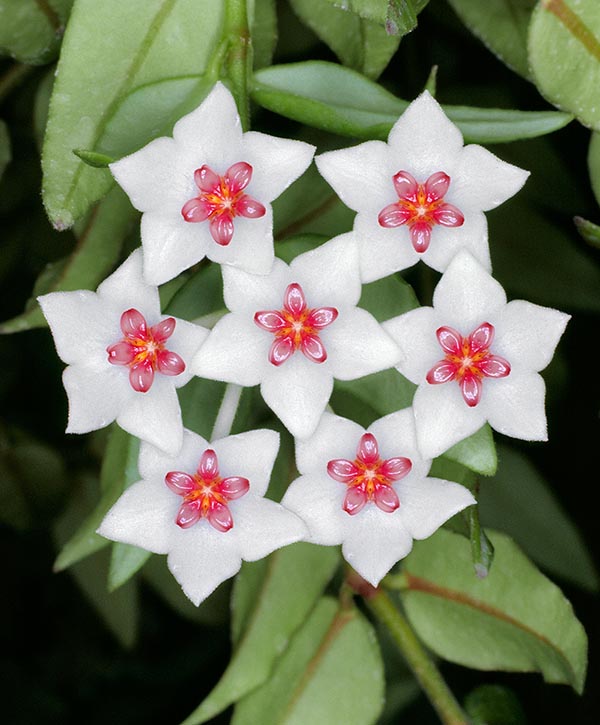Family : Apocynaceae

Text © Pietro Puccio

English translation by Mario Beltramini
The subspecies is native to India (Manipur) and Myanmar where it lives in the mountainous humid forests.
The genus is honoured to Thomas Hoy (ca. 1750-1822), botanist and curator of the gardens of the duke of Northumberland; the name of the species is the Latin adjective “lanceolatus, a, um” = lanceolate, with reference to the shape of the leaf, that of the subspecies is the Latin adjective “bellus, a, um” = beautiful , with obvious reference.
Common names: miniature wax plant (English).
The Hoya lanceolata subsp. bella (Hook.) D.H. Kent (1981) is an evergreen perennial suffruticose epiphyte, very ramified at the base, with long stems, rather thin, pubescent, initially erect, then drooping, if they do not have a support on which to lean, and close nodes. The leaves, on a 2-3 mm long petiole, are opposite, ovate-lancelate to trapezoidal with acuminate apex, entire margin and prominent central vein, fleshy, of dark green colour above, pale below, 2-4 cm long and 1,5-2 cm broad.

Suffruticose epiphyte, very ramified at the base, native to India and Myanmar, Hoya lanceolate bella is frequent in cultivation. Drooping inflorescences with 7-11 perfumed flowers, of about 1,5 cm of diameter © Giuseppe Mazza
The fruits, rarely produced in cultivation, are thin follicles, 12-15 cm long, containing numerous seeds, 2 mm long, provided at one extremity of a tuft of sericious hairs (pappus), about 2,5 cm long, that facilitates their dispersion with the wind.
It easily propagates by cutting, provided of 2-4 nodes, in late spring or early summer, in loam with addition of siliceous sand per a 30% or agriperlite maintained constantly humid, but without stagnations, at the temperature of 24-26 °C.
Introduced in cultivation in Europe in the middle of the XIX century, as Hoya bella, it reached in extremely short time a popularity second only to that of the Hoya carnosa thanks to its beauty and the fragrance of its flowers, produced abundantly, and the easiness of cultivation in apartment.
In open air it can be cultivated in the tropical and subtropical regions and marginally in the milder temperate-warm climate ones, needs a high luminosity, also filtered sun light, and ambient humidity, is therefore to be placed in a particularly humid zone of the garden. In the least favourable climates is to be cultivated in pot, preferably suspended, to be sheltered in the coldest months in a protected and luminous ambient, even with some hours of direct sun in the morning, far from heat sources and possibly in association with other plants thus to create a humid microenvironment. It needs a very porous and draining substratum, being easily subject to radical rottenness, neutral or slightly acidic, and regular waterings in summer, in order to keep it constantly humid, but without stagnations, with frequent nebulizations with non calcareous water at ambient temperature in presence of dry air and high temperatures.
In winter the waterings must be reduced, but without ever allowing the substratum to dry up completely, otherwise we can have a premature fall of the leaves, with slight nebulizations if the humidity is too low. For the fertilizations, with monthly frequence in spring-summer, it can be utilized a product specific for epiphytic orchids or a balanced hydrosoluble fertilizer, with microelements, at 1/3 the dosage reported on the package. The repottings are to be done in late spring when the loam is not any more perfectly permeable or the roots have filled up the pot, maintaining for various days the new substratum just humid and nebulizing the leaves, until the first signs of vegetative regrowth.
Synonyms: Hoya bella Hook. (1848).
→ To appreciate the biodiversity within the APOCYNACEAE family please click here.
